She is a mother of two, for starters, and she works at pharmaceutical company Sanofi as a director of analytical science and technology.
She also is board president at the Wellesley Chinese Language School, an institution she helped launch a decade ago because she saw a glaring need for the language and cultural instruction it could provide. She and her co-founders worked night after night into the wee hours to make the school a reality.
Despite all these responsibilities, however, Kochling is driven by a need to push herself even further. She is not content to be still. “I love challenges,” she says. “I am constantly looking for new ideas.”
For that reason, Kochling enrolled at Babson. She always had wanted to earn an MBA, and with her children growing older—one now in college and the other in high school—she thought the time was right. She hopes the degree will be a springboard for more career opportunities.
Earning an MBA also allows her to experience the joyful and fulfilling act of learning, something she values greatly. “Learning is part of me,” Kochling says. “I love to learn new things.”
Babson is a place that believes learning doesn’t end at age 21 with a walk across the stage and a mortarboard toss into the air. For sure, balancing education with adulthood’s many commitments isn’t always easy, but continuing to pursue learning opportunities can be rewarding and, frankly, essential to a vibrant career. With extensive courses and programs available at Babson Executive Education (BEE) and the F.W. Olin Graduate School of Business, including a fully online MBA degree launching in January, the College believes it can be a lifelong home for those seeking knowledge.
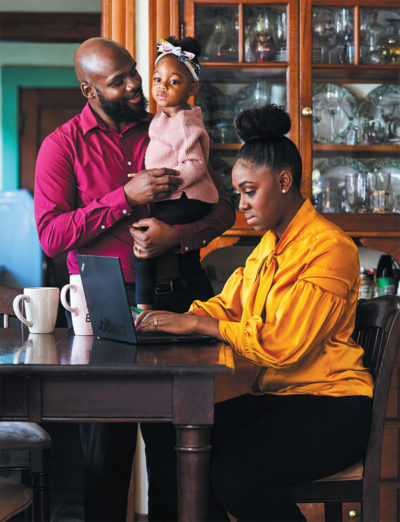
Chavon Cham MBA’18 at home with her husband, Gilbert, and daughter, Noah.
Photo: Pat Piasecki
“We can be here when you’re an undergrad, and a grad, and an early-stage professional, and as you advance throughout your entire career,” says Karen Hebert-Maccaro, BEE’s CEO. “We want to partner with you for every stage of your life.”
Constantly Evolving
Learning can’t stop because the world doesn’t stop. Technology is moving forward. Skills grow outdated. “Work is constantly evolving as it becomes more global and digital, and most jobs are slowly being replaced or reimagined through technology,” says Keith Rollag, the Murata Dean of the graduate school. “Staying productive, successful, and employable over time means we need to constantly learn new things.”
Hebert-Maccaro recommends that employees look at learning almost like going to the gym. “For physical survival, you need to pay attention to what you eat and how you exercise,” she says. “For intellectual survival, you need to exercise those mental muscles as well.” And, just like going to the gym, finding the time to learn can be a challenge. “We all have to juggle a lot in our lives,” Hebert-Maccaro says. “The most successful people will figure out how to juggle family, life, and continuous professional reinvention.”
Dr. Jason Simon MBA’20 knows all about that juggling. He’s an orthopedic surgeon at Newton-Wellesley Hospital, and sometimes when he’s supposed to be in class, he’s in the operating room.
He’s also the father of two daughters in grade school, and they occasionally pop up on the screen when he’s on a WebEx conference with his Babson classmates. Additionally, Simon is a senior executive at 1854 Cycling Company, a bicycle and apparel brand that provides jobs to formerly incarcerated people. “It’s a big social mission project, and that’s why I make time for it,” he says.

Dr. Jason Simon MBA’20 at Newton-Wellesley Hospital.
Photo: Michael Quiet
Of course, Simon is used to going to school and being busy. He is a doctor, after all. He experienced the whirlwind that is medical school. “In medicine, school never ends anyway,” he says. “I am fairly certain I haven’t slept since 1997.”
Simon decided to earn his MBA because the business of medicine is shifting. “It’s not really run by physicians but by practice managers who have a business, not a clinical, background,” he says. Finding himself surrounded by people “throwing out business terms,” essentially speaking a language he didn’t understand, Simon decided to apply to Babson. “The reason I’m in medicine is to take care of people,” he says, “but if that’s hampered by the way medicine is changing, you have to change.”
Like Simon, Chavon Cham MBA’18 decided to pursue an MBA to aid her career. When she studied at Babson, she was a New Balance product manager but preparing for a shift. Instead of focusing on product creation, she was aiming for a position that was more strategic, more global, more big picture. “I wanted to manage the business from a strategic point of view,” says Cham, who today is a global product manager for women’s lifestyle footwear at New Balance.
Also like Simon, Cham had to do some juggling to make her education work. During her time at Babson, she not only gave birth to her daughter, but she also planned a wedding. “It was very busy,” she says. Cham’s professors and fellow students were supportive, however, and she learned to manage expectations with class projects. “I couldn’t be the first person on every discussion board every week. There were times I had to flex,” she says. “It was about setting boundaries.”
Cham was enrolled in the Blended Learning MBA program, and she found its mix of online and in-person sessions provided flexibility that worked well for her bustling life. “You picture an MBA to be way more stuffy and conservative,” she says. “That wasn’t the experience for me at all. It was feasible and doable.”
Always a Babson Student
The Blended Learning program may be flexible, but some potential students live too far away to be able to come to campus regularly. Babson is striving to change that. “We want to expand our impact by reaching more students,” says D.R. Widder MBA’99, Babson’s vice president of innovation. “We want to foster entrepreneurship and Babson everywhere, and being online is a prerequisite to being everywhere.”
In January, Babson will begin offering an MBA program fully online. Other online programs will follow. “The main goal of online is to reach those students who can’t reach us,” says Widder. “We want to give people a way to get the world’s best entrepreneurship education wherever they are.”
Increasing access to what Babson offers is a goal at BEE as well. It already provides a robust selection of open enrollment and custom programs for individuals and companies, but Hebert-Maccaro wants to do more. Whether an employee needs to solve a problem in the moment, requires a new skill, or clamors for a complete career transformation, she wants BEE to be the place where they can gain that expertise. To do that, BEE could provide a variety of offerings—a class, of course, but also a podcast, a video, or whatever else is required. “I am bullish when I’m thinking about the potential Babson has,” says Hebert-Maccaro.
The mission is to further empower a life to be spent in learning, a life only beginning when one crosses the stage with a diploma in hand. “We all should be continually learning,” Widder says. “Once a Babson student, you are always a Babson student.”
]]>Now in its 21st year, the Black Affinity Network Conference is dedicated to strengthening the leadership and legacy between black alumni and current students, and providing networking and professional development opportunities for participants. The event also is a celebration of diversity, inclusion, and the achievements of individuals within the Babson College community. – Brianna Radicioni
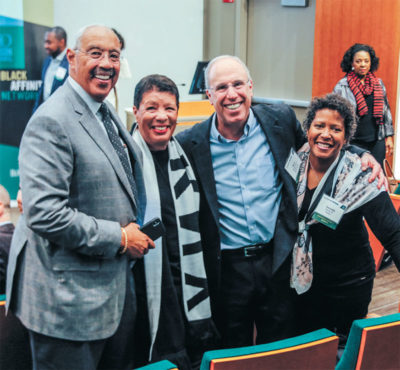
Photos by Chao Zheng Li
From left: Eric Johnson ’72, P’08; vice president for programming and community outreach Jane Edmonds; president-elect Stephen Spinelli Jr. MBA’92, PhD; Amanda Strong ’87
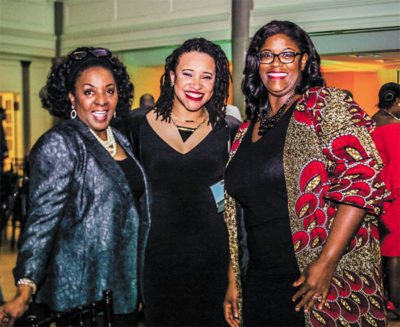
From left: Chief diversity and inclusion officer Sadie Burton Goss; BAN president Katrina Fludd ’08, MS’10; associate professor Tina Opie
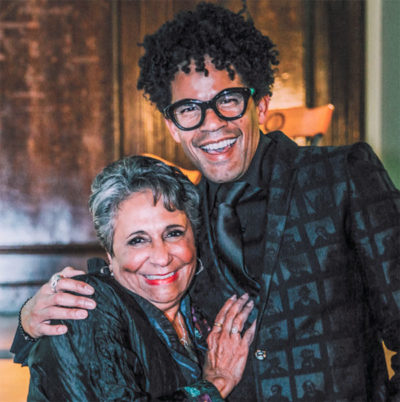
BAN honoree Cathy Hughes (left), Aaron Walton ’83
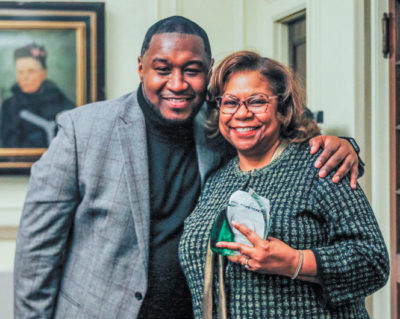
Conference co-chair Shatiek Gatlin ’16 (left), Affinity Award winner Jeannette F. Angles, Babson’s ARM-E risk manager
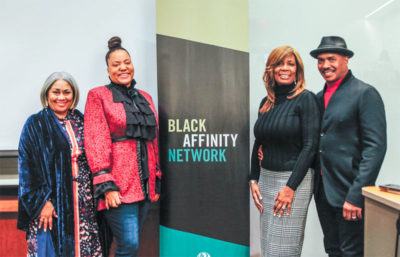
From left: Dyana Williams, Lynn Scott, Vivian Scott Chew, Ray Chew.

Alumni, students, and community members attended this year’s Black Affinity Network Conference that included panel discussions and awards.
]]>But just a few days later, national events prompted him to put aside that plan. On July 6, a black man named Philando Castile was fatally shot by a police officer during a routine traffic stop in Falcon Heights, Minnesota. Then on Friday, July 8, Ryan woke to learn that a sniper had killed five police officers in Dallas the night before during a protest against police brutality. “I realized that there was something bigger than my plan,” he says.
Ryan consulted with his core leadership team and sent what he considered to be “a fairly unspecial email” to the company, acknowledging the events. “It said, ‘It troubles me, I’m sure it troubles you, and we don’t have the answers. But I want to let you know I care, it’s on my mind, and we should feel free to talk to one another about it,’” Ryan recalls.
Hundreds of PwC employees responded to Ryan, but one email stood out: A woman thanked him for encouraging people to talk, because when she arrived at work that Friday, she said, “The silence was deafening.” The words were a wake-up call. “Here we were, one of the most progressive organizations in the world,” Ryan says, “yet when the country was feeling down because something bad had happened, our people couldn’t talk about it.”
He decided PwC’s 50,000 employees needed a chance to talk. He chose a day and encouraged everyone to step away from client work for an event called ColorBrave. Employees could converse in groups ranging in size from two to 200 people, but they had to follow a few simple rules: Be respectful, talk about how you feel, and focus not on “right” or “wrong” but on understanding each other.
In Ryan’s group, he heard one black employee describe what it’s like to earn a significant salary yet have people question whether his car really belongs to him. A white employee described the social challenges of her interracial marriage to a police officer. Participants found the experience moving. Someone commented to Ryan: “We shed more tears on July 21, 2016, than we did in our entire 160-year history.”
Babson strives to be an inclusive, intentionally diverse community, from students to faculty, staff, alumni, and external partners. But diversity is a complex issue, says Sadie Burton-Goss, chief diversity and inclusion officer at Babson. “Diversity is about race, gender, ethnicity, nationality, socioeconomics,” she says. Building, supporting, and retaining a diverse community takes commitment, collaboration, and work.
Read More…
Corporate efforts to address diversity and inclusion—usually by hiring employees of various backgrounds, from gender and race to ethnicity and sexual orientation and more—are not new, of course. Ryan notes that decisions by the two PwC chairmen before him laid the groundwork for his leadership team, which includes women, minorities, and an employee who identifies as LGBTQ. The company reports that women make up 47 percent of its workforce and minorities 33 percent. But Ryan stresses that more work needs to be done and that real progress in diversity and inclusion involves more than percentages.
Ryan’s actions, along with the work of other Babson alumni, suggest the dawn of a new era in the effort to diversify corporate America. “We should be the generation of leaders that makes inclusion a reality for America once and for all,” Ryan says.
Diversity Is Good for Business
As a gay black man, Aaron Walton ’83 has always known what it means to stand apart. Growing up in the Boston neighborhood of Roxbury, he was one of the first kids to participate in a program that bused mostly minority children from inner-city neighborhoods to schools in affluent, mostly white suburbs. His parents then moved the family to Bellingham, Massachusetts, where someone circulated an unsuccessful petition to push the African-American family out of the neighborhood. Later, Walton’s parents sent him and his younger sister, Valerie ’85, to a private school for grades 7 to 12 and then to Babson. “At every school, my sister and I were usually the only black kids there,” he says. He often felt the weight of people’s misconceptions and stereotypes, fielding such questions as why he didn’t “sound” black. Back then, he coped by shrugging off those comments.
When Walton joined PepsiCo after graduation, he began to see his differences as beneficial and a source of fresh ideas. His supervisors agreed. Walton started as an analyst and then moved to brand management and the entertainment marketing team, where he was valued as an expert on pop culture and the entertainment business. “Being black and gay exposed me to a wider range of art forms than some of my colleagues,” he says. Walton focused on ways that PepsiCo could use art, music, and film to tell the brand’s story, developing sponsorship deals with acts such as Gloria Estefan, Tina Turner, and Michael Jackson, among others.
Walton eventually left PepsiCo to spend 13 years at his own entertainment marketing agency. But he wanted to fulfill a longtime dream of working in advertising, so in 2005 he co-founded his own agency, Walton Isaacson, with colleague Cory Isaacson and backing from former basketball star Magic Johnson. Walton and Isaacson set out to create what they called “the world’s most interesting agency,” one that celebrates all kinds of diversity. “We understood that diversity ultimately leads to innovation,” Walton says. “When we’re surrounded by people who aren’t like us, we work harder to marshal our arguments to convince people why things need to evolve or be different. That can’t happen if everyone thinks the same, looks the same, comes from the same background.”
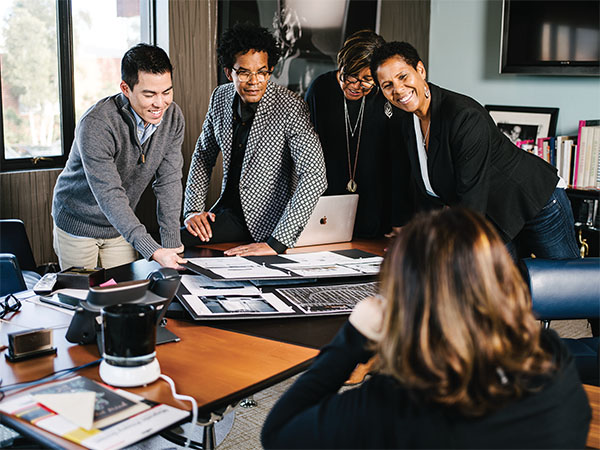
Photo: Mathew Scott
Aaron Walton ’83 encourages collaboration among all employees at his agency, Walton Isaacson.
Today the agency employs a remarkably diverse team, with more women than men and staff members who identify as black, Asian, Latino, mixed race, and LGBTQ. Walton is careful not to “silo” or limit his team by, for example, having Latino staff members work only on Latino accounts—an approach that is common, he says, at traditional ad agencies. Clients and employees benefit from exposure to a range of perspectives, he believes. Early in his career, Walton tended to ignore narrow-minded comments from clients, but not anymore. “I finally began to work with clients to explain the negative impact that stereotypical assumptions were having on their business,” he says. “It’s not a difficult concept. Let’s own and celebrate our diversity and all of the amazing things that come along with expanding our view of the world instead of marginalizing these cultures.”
Walton celebrates his own identity and also encourages employees to be fully themselves. “Being able to celebrate all of who we are is freeing,” he says. “People are less focused on conforming and more focused on innovation and being able to provide a point of view that no one else has.”
Diversity efforts at Babson go right to the top. Amanda Strong ’87, a Babson trustee, has worked with President Kerry Healey and others in the Babson community to make the Board of Trustees more representative of people of all backgrounds.
Read More…
Josuel Plasencia ’17 and Yulkendy Valdez ’17 say this level of acceptance is particularly appealing to millennial workers. The recent grads founded Boston-based Project 99, which helps companies teach young employees and their managers inclusive leadership skills, with the aim of retaining diverse talent and growing future leaders. “Professionals of color are three times more likely to quit their jobs, and this is costing companies an average of $6 billion a year,” Valdez claims. “Our idea is that if you’re able to put these millennials—who are going to become three-fourths of your workforce in less than 10 years—at the forefront of cultural change in the company, they are going to be more engaged, they’re going to feel more productive, and they will deliver for your bottom line.”
Studies show that more ethnically and racially diverse companies tend to outperform their less diverse competitors, say Plasencia and Valdez. The same goes for companies with more women leaders; they often have better financial performance than male-dominated competitors.
Plasencia and Valdez both were born in the Dominican Republic and moved to the U.S. as children. Plasencia was raised by a single mother in New York after his father was deported. Valdez lived near Ferguson, Missouri, and often worried about her little brothers when she saw news of a person of color dying at the hands of police. The two founders chose the name of their company after learning about the human genome at the 2014 Clinton Global Initiative conference; President Bill Clinton mentioned that 99.9 percent of human genes are identical, and differences among people account for only 0.1 percent of our genetic material. “We’re always asking, ‘How can you create leaders that embrace that common humanity that we all have but leverage the unique differences that we all bring to the table?’” Valdez says. “Imagine if Josuel was able to talk openly at work about his family, about living with a single mother and having a deported father. Imagine how much more at ease I would feel at work if I was able to talk about how police brutality in the African-American community impacted me growing up in St. Louis. These are the things we’re trying to do with Project 99, to help companies let out the 0.1 percent in all of our cultures so that people can be more engaged and more productive at work.”
Helping employees feel included and respected can be as simple as offering a listening ear, says Minea Moore, MBA’08, director of diversity and inclusion strategic initiatives at Intel. To that end, the high-tech company created the WarmLine, a program designed to help retain employees and staffed by advisers who troubleshoot a variety of confidential topics, especially around career goals. Since 2016, the line has processed around 10,000 cases, and research shows that 90 percent of those employees stay at Intel. Moore adds that hiring and retaining people with different ethnicities, genders, and sexual orientations creates important diversity of thought and different perspectives within a company. This kind of thinking, Moore says, can benefit the bottom line.
Nicole McCabe ’96 is now vice president of strategic initiatives in corporate development at software company SAP and was its global head of gender equality for almost five years. She says companies ignore diversity and inclusion at their peril and offers the example of Uber, which faced a dip in ridership after a female engineer detailed rampant sexism at the company. “You see a lot of these startups that aren’t thinking about their culture early on,” she says, “and then they grow and they’re successful, but they have all of these issues embedded into their culture that create a huge financial risk.”
Commitment at the Top
In January 2015, Intel CEO Brian Krzanich stood on a stage at the Consumer Electronics Show, which attracts almost 180,000 attendees and garners worldwide media coverage, and made a dramatic pledge: By the end of 2018, Intel would reach “full representation” within its workforce. “That means when you look at the makeup of employees inside Intel, it should match the available talent pool outside Intel,” Moore says. In the same speech, Krzanich committed $300 million to support that goal and accelerate diversity and inclusion, not just at Intel but across the technology industry.
Intel’s approach to diversity and inclusion is grounded in data. “We believe that what we measure gets done,” Moore says. “By setting measurable goals based on data, we’re able to ensure that we’re progressing.” These efforts appear to be working: In a total U.S. workforce of about 50,000, the gap to full representation is about 800 people today, down from 2,300 in 2014.
Ryan of PwC agrees that diversity efforts must start with company leaders. “The tone at the top and executive commitment is the single most important thing,” Ryan says. He adds that talented CEOs are particularly well-equipped to tackle tough problems creatively. “They can get transformative deals done,” he says. “They can be entrepreneurial. They can develop new technology. They can raise money and sell companies. When they put their minds to this, they can get it done.”
As a white man who spent his early childhood in the then mostly white Hyde Park neighborhood of Boston before moving to a predominantly white suburb, Ryan may seem a surprising leader in the quest for diversity and inclusion. But he witnessed the Boston busing crisis in the mid-1970s, when a court ordered the desegregation of Boston city schools. The nightly news showed frightening footage of rioters throwing rocks at buses. Images from this confusing time stuck with him.
After the success of the first ColorBrave conversations at PwC, Ryan admits he breathed a sigh of relief and planned simply to continue with existing efforts to recruit diverse talent. But a member of his team pressed him about his influence with companies outside of PwC. What could Ryan do to promote diversity and inclusion elsewhere? “That really, really got me thinking,” he says. As he traveled the country, meeting as usual with PwC clients, Ryan asked CEOs about diversity. “It became clear that many were struggling with how to become more inclusive and were not quite sure how to do it but wanted to do better,” Ryan says.
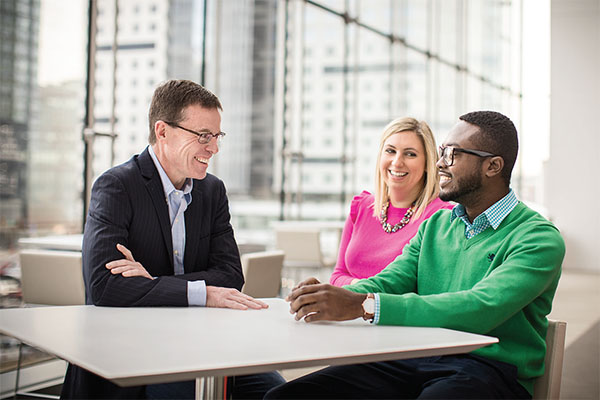
Photo: Tom Kates
Tim Ryan ’88 talks with employees in PwC’s Boston office.
He reached out to the CEO of consumer-goods company Procter & Gamble and the head of the Executive Leadership Council, an organization for the development of black leaders, as well as to PwC’s direct competitors. Conversations with these leaders eventually led PwC to launch an initiative called CEO Action for Diversity & Inclusion. Participating executives agree to take three steps: to create safe spaces in their companies for conversations about diversity, to provide training about unconscious bias to everyone, and to make best practices for diversity available to other businesses.
More than 360 companies now participate. This past November, 70 CEOs from these companies gathered in New York for a closed-door session about diversity, where leaders were encouraged to talk about uncomfortable topics. “We had an incredible day, where we all left smarter and maybe a little more courageous than we were coming in the door,” Ryan says. As part of its CEO Action initiative, PwC also recently added what it calls the President’s Circle, bringing academic institutions and associations on board. The goal is to engage students, faculty, and staff around issues of diversity and inclusion, given that students are the future employees and leaders of corporate America.
How to Recruit a Diverse Workforce
Finding qualified employees from diverse backgrounds is not as difficult as some people claim, believes Ryan. “I would say that’s one of my biggest pet peeves. We need to do a better job of finding the talent inside our organizations, broadening our recruiting nets and the like,” he says. “There’s so much talent out there in the world. To simply say it’s a talent pipeline issue, in my judgment, is a cop-out.” A CEO Action event addressed this issue, inviting 150 chief diversity officers and human capital officers to New York to share detailed strategies for inclusivity.
Several years ago, McCabe tackled the dearth of women in leadership roles at SAP by scheduling a two-day meeting on the topic. “I brought together everyone who handled core employee life-cycle processes—executive recruiting, our university recruiting folks, our succession planning folks, the people who handle leadership,” she says. “We talked openly about the data and the issues.”
They found, for example, that just 10 percent of employees in SAP’s fast-track leadership program were women. “The intent of the program was to accelerate future leaders, but how can you increase diversity when the primary recruiting pool is not diverse?” McCabe notes. So the group discussed ways to boost women applicants. “It was a great opportunity for everyone to get on the same page and understand the impact of their area on the greater goal,” she says. “Once you put the data up there, no one can really argue with it.” The proportion of women in leadership roles at SAP rose from 19 percent in 2011 to 25 percent in 2017, meeting goals the firm had set six months ahead of schedule.
In April 1998, a Black Affinity meeting at Babson led to the first Black Affinity Conference, now observing its 20th anniversary. Created to engage and retain students, improve recruitment, and re-engage alumni from the black community, the BAC continues to bring people together for learning, networking, and celebrating.
Read More…
Intel hopes that boosting STEM programs in schools will ultimately yield a larger, more diverse pool of technically trained employees in the future. In 2015, the company announced a $5 million investment in the Oakland Unified School District in California, including close partnerships with the district’s largest high school, Oakland Technical, and McClymonds High School, where students of diverse backgrounds make up about 90 percent of the population. The grant funded a new position to oversee the district’s computer science programs and a new computer science curriculum, as well as mentoring and summer internships at Intel. “When you look at how to fill the lack of diversity in technology, you need to start earlier than college,” Moore says. The changes already have helped, she says, pointing to a dramatic increase in the number of Oakland students taking computer science classes in the past two years.
While the company is making steady progress in its efforts to hire women and Hispanic and Native American employees, Intel is still lagging in its goals around the hiring, progression, and retention of African-American employees, Moore says. So Intel is increasing its focus on retention efforts and expanding recruitment at historically black colleges and universities. It also plans to host an African-Americans in Tech Thought-Leadership Summit to consider new ways to attract and keep black employees in these roles.
Plasencia of Project 99 says that one secret to retention is giving young minority employees opportunities to lead projects and teams. “This increases their ability to have a voice and makes them a stronger part of your organization,” he says. “They are more likely to stay and want to grow in the company.”
Companies also need to look at the role that unconscious bias—the judgments and assessments that people make without realizing they are doing as much—may play in hiring, Walton says. “I think every organization has it,” he says. “It helps to start to understand how it impacts your hiring decisions or impacts the clients you go after.” Making diversity “part of the DNA” of a company from the beginning, as Walton and his co-founder did, can help safeguard against such biases. Emphasizing a true willingness to listen intently to other people also is key, Walton adds. “Too often, people enter a conversation with a mental checklist of what they want out of it,” he says, “and their brains check out as soon as they establish that the other person meets their expectations—or doesn’t.”
A growing number of companies offer unconscious-bias training to help workers understand blind spots around diversity. PwC developed its training with Mahzarin Banaji, a Harvard professor and co-author of Blindspot: Hidden Biases of Good People. Ryan describes one scenario offered in PwC’s training: A car crash occurs, killing a father and gravely injuring his son. When the son arrives at the hospital, the surgeon says, “I can’t operate. This is my son.” Many people respond by wondering how that’s possible, given that the father died. But the surgeon is actually the patient’s mother. PwC requires the training for all new employees, as well as for established employees who want to be considered for a promotion. PwC’s President’s Circle also is calling on university leaders to help build diversity and inclusion course offerings into their curricula, and it has created a campus tour called Check Your Blind Spots, which pushes students to consider such issues before they enter the workforce.
Intel’s Moore acknowledges that corporate diversity training touches on sensitive topics. The company offers Managing at Intel, a program that includes diversity and inclusion training for its managers. “This stuff is hard,” she says. “You hear things that may hurt, and those unconscious biases are not an easy pill to swallow. But a healthy dialogue, actually having a discussion about it, is necessary to really drive change.”
Moving Away from Mandates
In her second job out of college, Moore, who is African-American, had a conversation with an older white male colleague. He expressed opposition to what he called “affirmative action” programs, which he believed hurt the employees they were designed to help. After working together for about a year, the colleague gushed to Moore that he was really impressed with her work. “I connected the dots back and realized that he probably thought I originally got that job not because of my capabilities, but because of ‘affirmative action,’” she recalls. “It was the first time that I realized people might be looking at me differently.”
During her career, Moore has seen thinking about diversity and inclusion initiatives change. Instead of viewing such programs as a way to comply with mandates and legal requirements, companies now are more likely to see them in terms of the tangible value they bring to businesses, she says.
Diversity and inclusion experts are working to move employees away from viewing diversity initiatives as an imposition. McCabe of SAP has come to realize that empathy is a key ingredient in making these programs productive. She helped boost SAP’s existing Business Women’s Network, and with a colleague she co-founded the Leadership Excellence Acceleration Program, which prepares women for leadership roles. McCabe notes that in 2016, SAP became the first tech company to earn Economic Dividends for Gender Equality (EDGE) certification, a global business standard for evaluating gender equality.
Sensing a lack of connection among female colleagues, McCabe also established a less-formal collaboration website to build community among SAP women. It features a webinar series, attended by women across the company. She chuckles thinking about the distancing politeness of the first webinars. Within a few sessions, however, attendees grew more candid and started sharing personal stories. One woman talked about a recent cancer diagnosis, for example, and women from all over the world chimed in to offer support. “You could see the trust and support that they started to bring to one another,” McCabe says.
Experiences like those reshaped her thoughts about what makes diversity initiatives effective. “Now it’s more, how do we evoke empathy for people? How can we help our employees have conversations, and, in some instances, relearn the process of agreeing to disagree?” McCabe says.
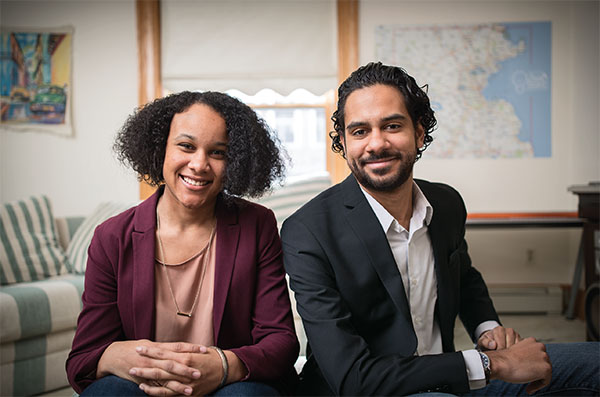
Photo: Tom Kates
Yulkendy Valdez ’17 (left) and Josuel Plasencia ’17, co-founders of Project 99
Valdez and Plasencia agree that stilted, forced conversations about race and diversity need to be replaced. “You’ve got to turn a transactional conversation into a human conversation again, which is going to be hard because these topics have been so politicized, especially recently, and have become very tense,” Valdez says. “You’ve got to find a way to sit in a room, starting with small pockets of your organization, and just talk about your own personal story. Start there, and then talk about how this has personally impacted you.”
Diversity and inclusion are worthy causes, Ryan reiterates. “It happens to be the right thing to do,” he says. At the same time, corporations will benefit from these initiatives. “When we make our companies more diverse,” Ryan says, “we create our country’s biggest competitive advantage.”
Erin O’Donnell is a writer in Milwaukee.
]]>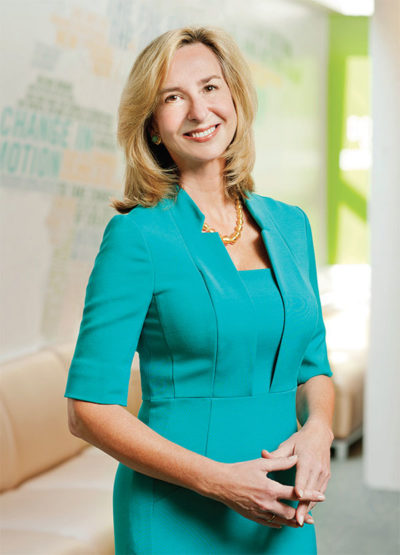
Photo: Webb Chappell
Babson President Kerry Healey
During the past several years, Babson’s incoming undergraduates have been increasingly and intentionally diverse. The Class of 2021 is 52 percent women, 28 percent international, 44 percent U.S. students of color, and 28 percent historically underrepresented minorities. It also is the most competitive and well-qualified class in Babson history.
Diversity of all kinds extends to socioeconomic circumstances, and we are working to ensure that a Babson education is accessible to exceptional students regardless of financial means. This year, we awarded $37 million in institutional grants and scholarships. The Class of 2021 includes 14 percent Pell Grant recipients, a percentage we hope to increase in coming years. And, for the first time in nearly two decades, Babson met 100 percent of need for incoming domestic students.
Among those granted scholarships is a group of Diversity Leadership Award recipients selected for their potential to lead and foster an inclusive community at Babson. Next fall, the planned cohort will include public school students from Babson’s Hub locations of Boston, San Francisco, and Miami. As part of our vision to make Entrepreneurial Thought & Action accessible to everyone, everywhere, we have established small-footprint, high-impact Hubs in these communities, known for their entrepreneurship ecosystems, and we are pleased to extend these awards to local students.
It is important that we work to make historically exclusive environments—such as higher education—welcoming to all students, including those from communities where college attendance might not be the norm. Everywhere, in every situation, there are aspiring leaders with the potential to change the world for the better.
Our campus is enriched by varied perspectives and experiences, and our global network of 40,000 alumni and friends in 114 countries is equally dynamic. We are taking steps to ensure that Babson’s governance boards also are representative of all backgrounds and recently elected the first chairwoman of the Board of Trustees, Marla Capozzi, MBA’96.
I am reminded of the words that Ellen Johnson Sirleaf, H’17, former president of Liberia, shared at our 2017 Commencement exercises, in which she beautifully articulated the inherent inclusiveness of entrepreneurial leadership: “At a time when many around the world are looking to build walls, close doors, and limit interactions across cultures, the entrepreneur, by his or her own definition, is a bridge builder. A door opener. A problem solver. I salute you, the next generation of innovators and bridge builders.”
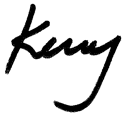
Kerry Healey
]]>
Illustration: Miguel Porlan
A group of 20 chefs from across the country arrived on campus last fall for a new five-day leadership program. Some were restaurateurs; others were bakers or artisanal coffee roasters or sold handcrafted ice cream.
They represented a range of culinary styles, but each had two traits in common: All were women, and all were inaugural fellows in the Women’s Entrepreneurial Leadership program, devised by Babson Executive and Enterprise Education for the James Beard Foundation (JBF), the New York-based national culinary nonprofit.
“Like most industries,” says Mitchell Davis, JBF’s executive vice president, “the food industry has a dearth of women leaders at a certain level.” The goal of the program is to support women who want to expand their businesses and hone their leadership skills. More than 90 applicants vied for 20 slots, which were offered as fellowships with all expenses covered by the foundation.
Davis explains that JBF had long sought to create a program that would help women in the field aim higher and imagine what’s possible. When, through a series of connections, Babson appeared on JBF’s radar, it seemed a perfect fit. Candida Brush, vice provost of global entrepreneurial leadership, and Victoria Sassine, adjunct lecturer, served as faculty directors for the program, which takes participants through such topics as managing staff, negotiations, finance, and value propositions. The week culminated with attendees making a final presentation detailing an action plan for growth.
More philosophically, Brush hoped the program would bring about a change in mindset for participants—transform them from puzzle solvers to quilt makers, as she puts it. Chefs, she notes, are task-oriented and tend to focus on the day-to-day. Instead, she says, “I wanted them to think about what it means to be more creative and more strategic.”
Carolyn Johnson, chef-owner of 80 Thoreau in Concord, Massachusetts, and Mooncusser Fish House in Boston, was excited to participate in the program. “I came away feeling very motivated and energized and exhausted,” she says, “with a greater understanding of my need to step away from my role as a cook and into my role as a business owner.”
The food industry is demanding for both men and women, but some of its challenges are unique to women. At a session on leadership and gender issues, several of the participants talked about feeling the need to walk the line between being liked and being respected. “That’s the double bind” for women managers, acknowledged session leader Susan Duffy, executive director of Babson’s Center for Women’s Entrepreneurial Leadership. “But here’s a hint,” she told the group. “You’re allowed to come back from a program like this and totally become the new boss.”
Brush says that though many of the week’s topics were not gender specific, “There is a benefit to having a single-sex cohort. They have common issues, and a cohort sisterhood is a little different from when you have a mixed group. It’s a safe space where you’re not being judged.” And, she adds, it facilitates forming a network of female peers.
Another participant, Elizabeth Wiley of Meadowlark Restaurant and Wheat Penny Oven and Bar in Dayton, Ohio, says the program was validating and empowering. But perhaps the most valuable takeaway was receiving the encouragement to think big. “The dream of doing what you want and succeeding at it,” she says. “That’s pretty heady stuff.”—Jane Dornbusch
]]>